Strategic Analysis of Business Environments: High Flyers & SCH
VerifiedAdded on 2020/10/12
|8
|3383
|95
Report
AI Summary
This report provides an in-depth analysis of the business environments of two companies: High Flyers Limited (HFL) and SCH. The first scenario focuses on HFL, examining its competitive pressures using Porter's Five Forces and analyzing the impact of external factors through a PESTEL framework. The analysis considers the threats of new entrants, substitute products, competitive rivalry, and the bargaining power of suppliers, as well as political, economic, social, and technological factors. The second scenario involves SCH, a home care service provider, and assesses its strategic position and options, considering demographic trends and market opportunities. The report highlights the importance of understanding both micro and macro environmental factors for businesses to adapt and thrive, offering insights into strategic planning and decision-making in dynamic market conditions. The report also discusses the challenges and opportunities in the context of the UK's economic and political landscape, including the impact of Brexit and government policies.
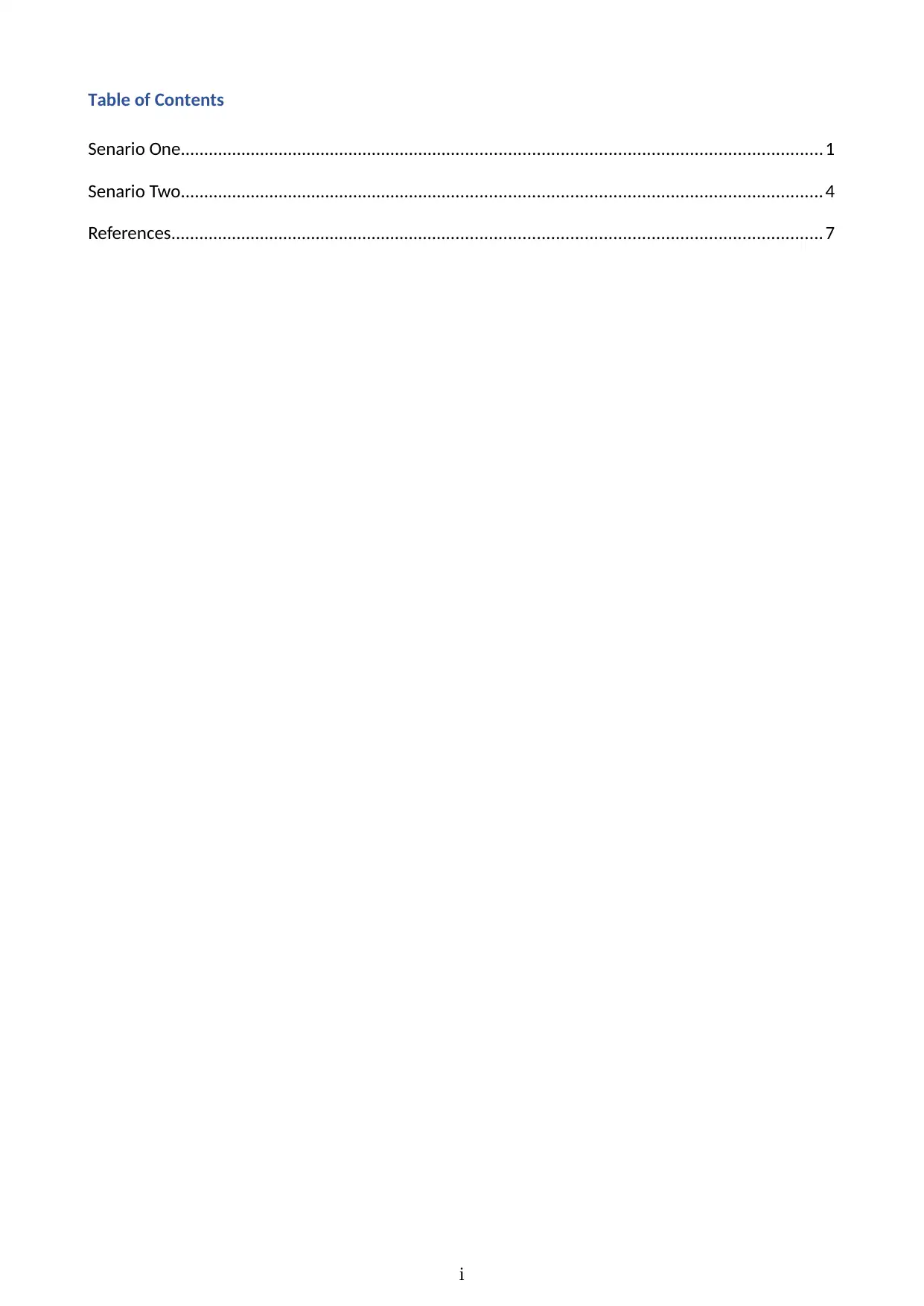
Table of Contents
Senario One........................................................................................................................................1
Senario Two........................................................................................................................................4
References.......................................................................................................................................... 7
i
Senario One........................................................................................................................................1
Senario Two........................................................................................................................................4
References.......................................................................................................................................... 7
i
Paraphrase This Document
Need a fresh take? Get an instant paraphrase of this document with our AI Paraphraser
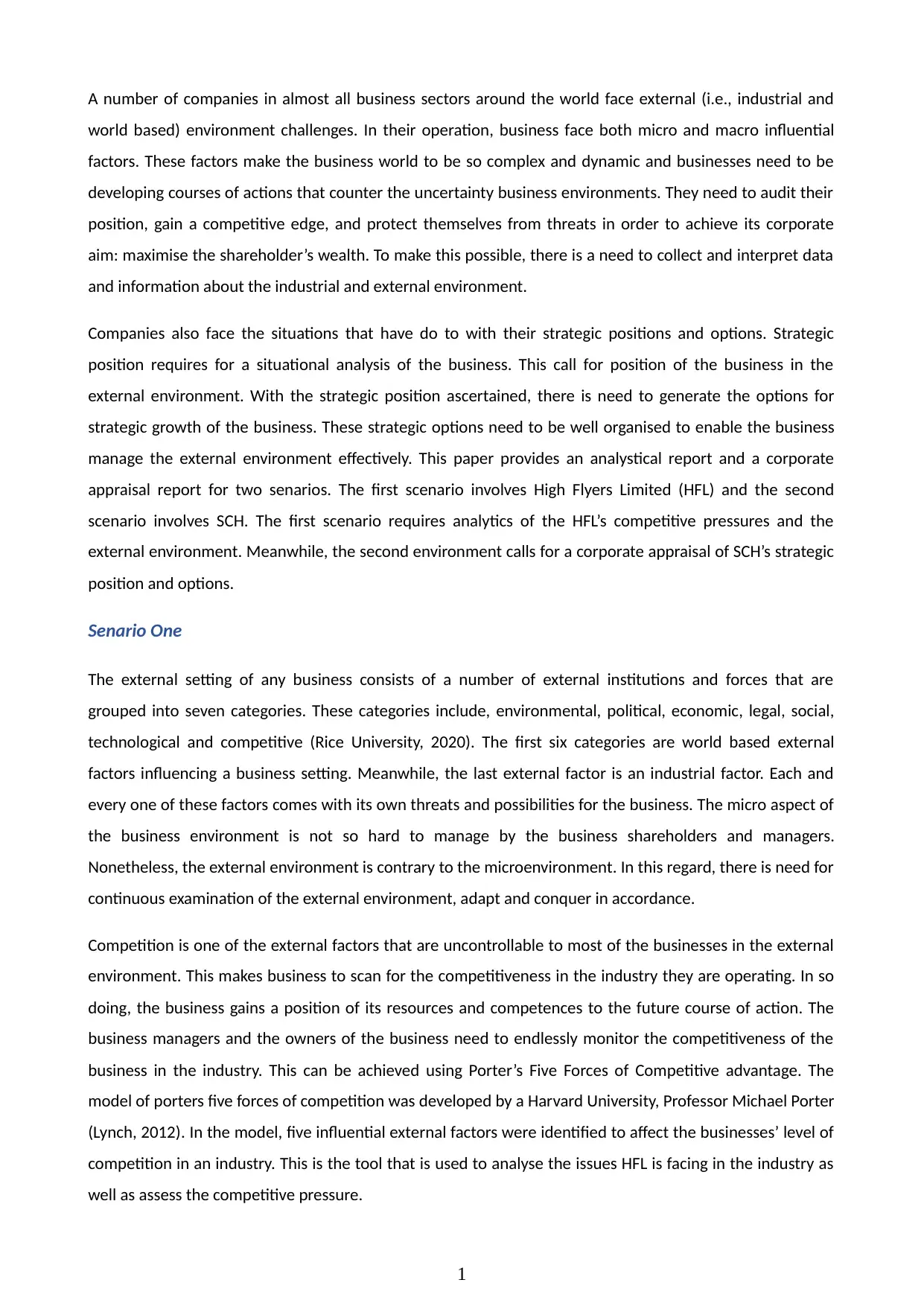
A number of companies in almost all business sectors around the world face external (i.e., industrial and
world based) environment challenges. In their operation, business face both micro and macro influential
factors. These factors make the business world to be so complex and dynamic and businesses need to be
developing courses of actions that counter the uncertainty business environments. They need to audit their
position, gain a competitive edge, and protect themselves from threats in order to achieve its corporate
aim: maximise the shareholder’s wealth. To make this possible, there is a need to collect and interpret data
and information about the industrial and external environment.
Companies also face the situations that have do to with their strategic positions and options. Strategic
position requires for a situational analysis of the business. This call for position of the business in the
external environment. With the strategic position ascertained, there is need to generate the options for
strategic growth of the business. These strategic options need to be well organised to enable the business
manage the external environment effectively. This paper provides an analystical report and a corporate
appraisal report for two senarios. The first scenario involves High Flyers Limited (HFL) and the second
scenario involves SCH. The first scenario requires analytics of the HFL’s competitive pressures and the
external environment. Meanwhile, the second environment calls for a corporate appraisal of SCH’s strategic
position and options.
Senario One
The external setting of any business consists of a number of external institutions and forces that are
grouped into seven categories. These categories include, environmental, political, economic, legal, social,
technological and competitive (Rice University, 2020). The first six categories are world based external
factors influencing a business setting. Meanwhile, the last external factor is an industrial factor. Each and
every one of these factors comes with its own threats and possibilities for the business. The micro aspect of
the business environment is not so hard to manage by the business shareholders and managers.
Nonetheless, the external environment is contrary to the microenvironment. In this regard, there is need for
continuous examination of the external environment, adapt and conquer in accordance.
Competition is one of the external factors that are uncontrollable to most of the businesses in the external
environment. This makes business to scan for the competitiveness in the industry they are operating. In so
doing, the business gains a position of its resources and competences to the future course of action. The
business managers and the owners of the business need to endlessly monitor the competitiveness of the
business in the industry. This can be achieved using Porter’s Five Forces of Competitive advantage. The
model of porters five forces of competition was developed by a Harvard University, Professor Michael Porter
(Lynch, 2012). In the model, five influential external factors were identified to affect the businesses’ level of
competition in an industry. This is the tool that is used to analyse the issues HFL is facing in the industry as
well as assess the competitive pressure.
1
world based) environment challenges. In their operation, business face both micro and macro influential
factors. These factors make the business world to be so complex and dynamic and businesses need to be
developing courses of actions that counter the uncertainty business environments. They need to audit their
position, gain a competitive edge, and protect themselves from threats in order to achieve its corporate
aim: maximise the shareholder’s wealth. To make this possible, there is a need to collect and interpret data
and information about the industrial and external environment.
Companies also face the situations that have do to with their strategic positions and options. Strategic
position requires for a situational analysis of the business. This call for position of the business in the
external environment. With the strategic position ascertained, there is need to generate the options for
strategic growth of the business. These strategic options need to be well organised to enable the business
manage the external environment effectively. This paper provides an analystical report and a corporate
appraisal report for two senarios. The first scenario involves High Flyers Limited (HFL) and the second
scenario involves SCH. The first scenario requires analytics of the HFL’s competitive pressures and the
external environment. Meanwhile, the second environment calls for a corporate appraisal of SCH’s strategic
position and options.
Senario One
The external setting of any business consists of a number of external institutions and forces that are
grouped into seven categories. These categories include, environmental, political, economic, legal, social,
technological and competitive (Rice University, 2020). The first six categories are world based external
factors influencing a business setting. Meanwhile, the last external factor is an industrial factor. Each and
every one of these factors comes with its own threats and possibilities for the business. The micro aspect of
the business environment is not so hard to manage by the business shareholders and managers.
Nonetheless, the external environment is contrary to the microenvironment. In this regard, there is need for
continuous examination of the external environment, adapt and conquer in accordance.
Competition is one of the external factors that are uncontrollable to most of the businesses in the external
environment. This makes business to scan for the competitiveness in the industry they are operating. In so
doing, the business gains a position of its resources and competences to the future course of action. The
business managers and the owners of the business need to endlessly monitor the competitiveness of the
business in the industry. This can be achieved using Porter’s Five Forces of Competitive advantage. The
model of porters five forces of competition was developed by a Harvard University, Professor Michael Porter
(Lynch, 2012). In the model, five influential external factors were identified to affect the businesses’ level of
competition in an industry. This is the tool that is used to analyse the issues HFL is facing in the industry as
well as assess the competitive pressure.
1
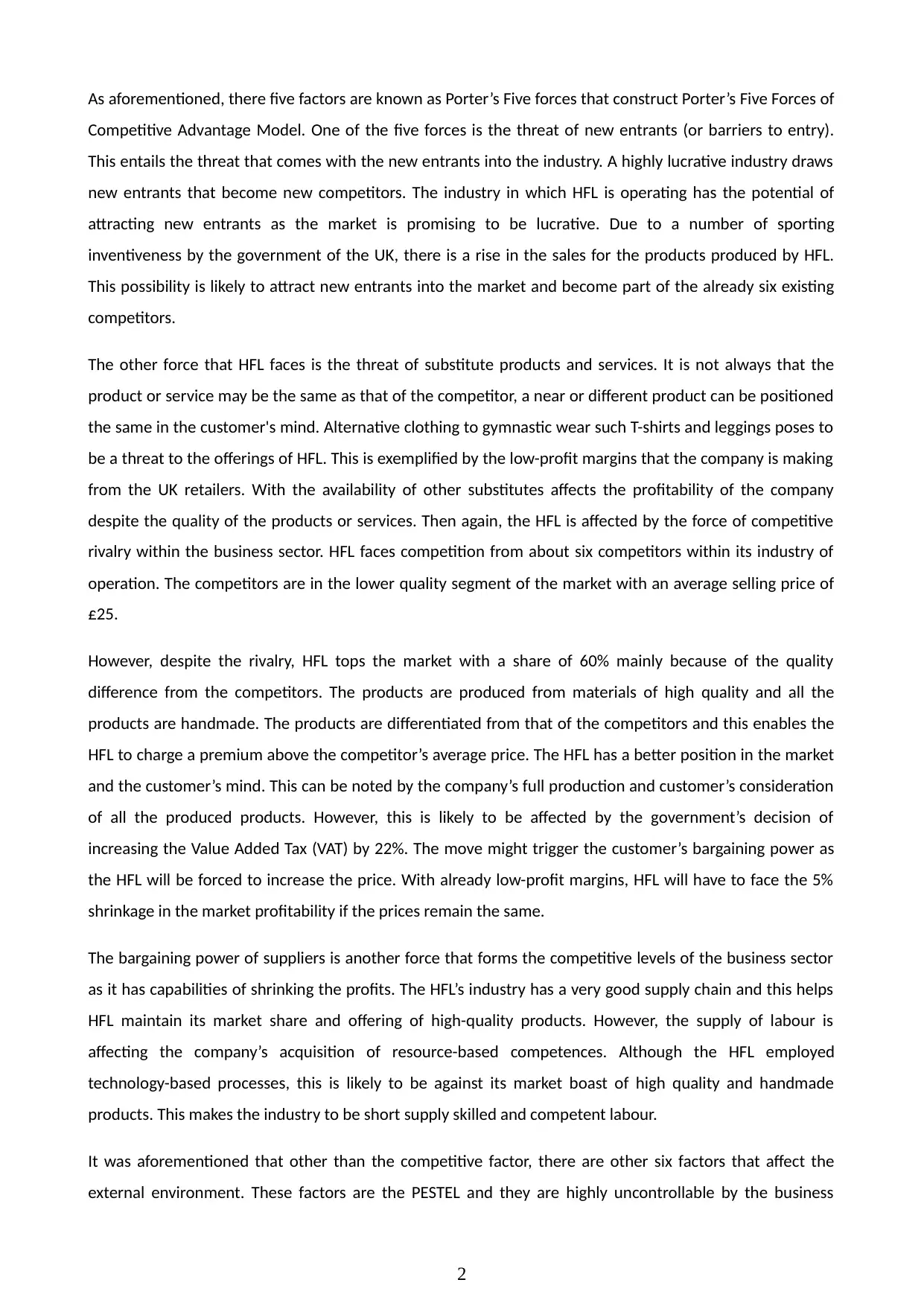
As aforementioned, there five factors are known as Porter’s Five forces that construct Porter’s Five Forces of
Competitive Advantage Model. One of the five forces is the threat of new entrants (or barriers to entry).
This entails the threat that comes with the new entrants into the industry. A highly lucrative industry draws
new entrants that become new competitors. The industry in which HFL is operating has the potential of
attracting new entrants as the market is promising to be lucrative. Due to a number of sporting
inventiveness by the government of the UK, there is a rise in the sales for the products produced by HFL.
This possibility is likely to attract new entrants into the market and become part of the already six existing
competitors.
The other force that HFL faces is the threat of substitute products and services. It is not always that the
product or service may be the same as that of the competitor, a near or different product can be positioned
the same in the customer's mind. Alternative clothing to gymnastic wear such T-shirts and leggings poses to
be a threat to the offerings of HFL. This is exemplified by the low-profit margins that the company is making
from the UK retailers. With the availability of other substitutes affects the profitability of the company
despite the quality of the products or services. Then again, the HFL is affected by the force of competitive
rivalry within the business sector. HFL faces competition from about six competitors within its industry of
operation. The competitors are in the lower quality segment of the market with an average selling price of
£25.
However, despite the rivalry, HFL tops the market with a share of 60% mainly because of the quality
difference from the competitors. The products are produced from materials of high quality and all the
products are handmade. The products are differentiated from that of the competitors and this enables the
HFL to charge a premium above the competitor’s average price. The HFL has a better position in the market
and the customer’s mind. This can be noted by the company’s full production and customer’s consideration
of all the produced products. However, this is likely to be affected by the government’s decision of
increasing the Value Added Tax (VAT) by 22%. The move might trigger the customer’s bargaining power as
the HFL will be forced to increase the price. With already low-profit margins, HFL will have to face the 5%
shrinkage in the market profitability if the prices remain the same.
The bargaining power of suppliers is another force that forms the competitive levels of the business sector
as it has capabilities of shrinking the profits. The HFL’s industry has a very good supply chain and this helps
HFL maintain its market share and offering of high-quality products. However, the supply of labour is
affecting the company’s acquisition of resource-based competences. Although the HFL employed
technology-based processes, this is likely to be against its market boast of high quality and handmade
products. This makes the industry to be short supply skilled and competent labour.
It was aforementioned that other than the competitive factor, there are other six factors that affect the
external environment. These factors are the PESTEL and they are highly uncontrollable by the business
2
Competitive Advantage Model. One of the five forces is the threat of new entrants (or barriers to entry).
This entails the threat that comes with the new entrants into the industry. A highly lucrative industry draws
new entrants that become new competitors. The industry in which HFL is operating has the potential of
attracting new entrants as the market is promising to be lucrative. Due to a number of sporting
inventiveness by the government of the UK, there is a rise in the sales for the products produced by HFL.
This possibility is likely to attract new entrants into the market and become part of the already six existing
competitors.
The other force that HFL faces is the threat of substitute products and services. It is not always that the
product or service may be the same as that of the competitor, a near or different product can be positioned
the same in the customer's mind. Alternative clothing to gymnastic wear such T-shirts and leggings poses to
be a threat to the offerings of HFL. This is exemplified by the low-profit margins that the company is making
from the UK retailers. With the availability of other substitutes affects the profitability of the company
despite the quality of the products or services. Then again, the HFL is affected by the force of competitive
rivalry within the business sector. HFL faces competition from about six competitors within its industry of
operation. The competitors are in the lower quality segment of the market with an average selling price of
£25.
However, despite the rivalry, HFL tops the market with a share of 60% mainly because of the quality
difference from the competitors. The products are produced from materials of high quality and all the
products are handmade. The products are differentiated from that of the competitors and this enables the
HFL to charge a premium above the competitor’s average price. The HFL has a better position in the market
and the customer’s mind. This can be noted by the company’s full production and customer’s consideration
of all the produced products. However, this is likely to be affected by the government’s decision of
increasing the Value Added Tax (VAT) by 22%. The move might trigger the customer’s bargaining power as
the HFL will be forced to increase the price. With already low-profit margins, HFL will have to face the 5%
shrinkage in the market profitability if the prices remain the same.
The bargaining power of suppliers is another force that forms the competitive levels of the business sector
as it has capabilities of shrinking the profits. The HFL’s industry has a very good supply chain and this helps
HFL maintain its market share and offering of high-quality products. However, the supply of labour is
affecting the company’s acquisition of resource-based competences. Although the HFL employed
technology-based processes, this is likely to be against its market boast of high quality and handmade
products. This makes the industry to be short supply skilled and competent labour.
It was aforementioned that other than the competitive factor, there are other six factors that affect the
external environment. These factors are the PESTEL and they are highly uncontrollable by the business
2
You're viewing a preview
Unlock full access by subscribing today!
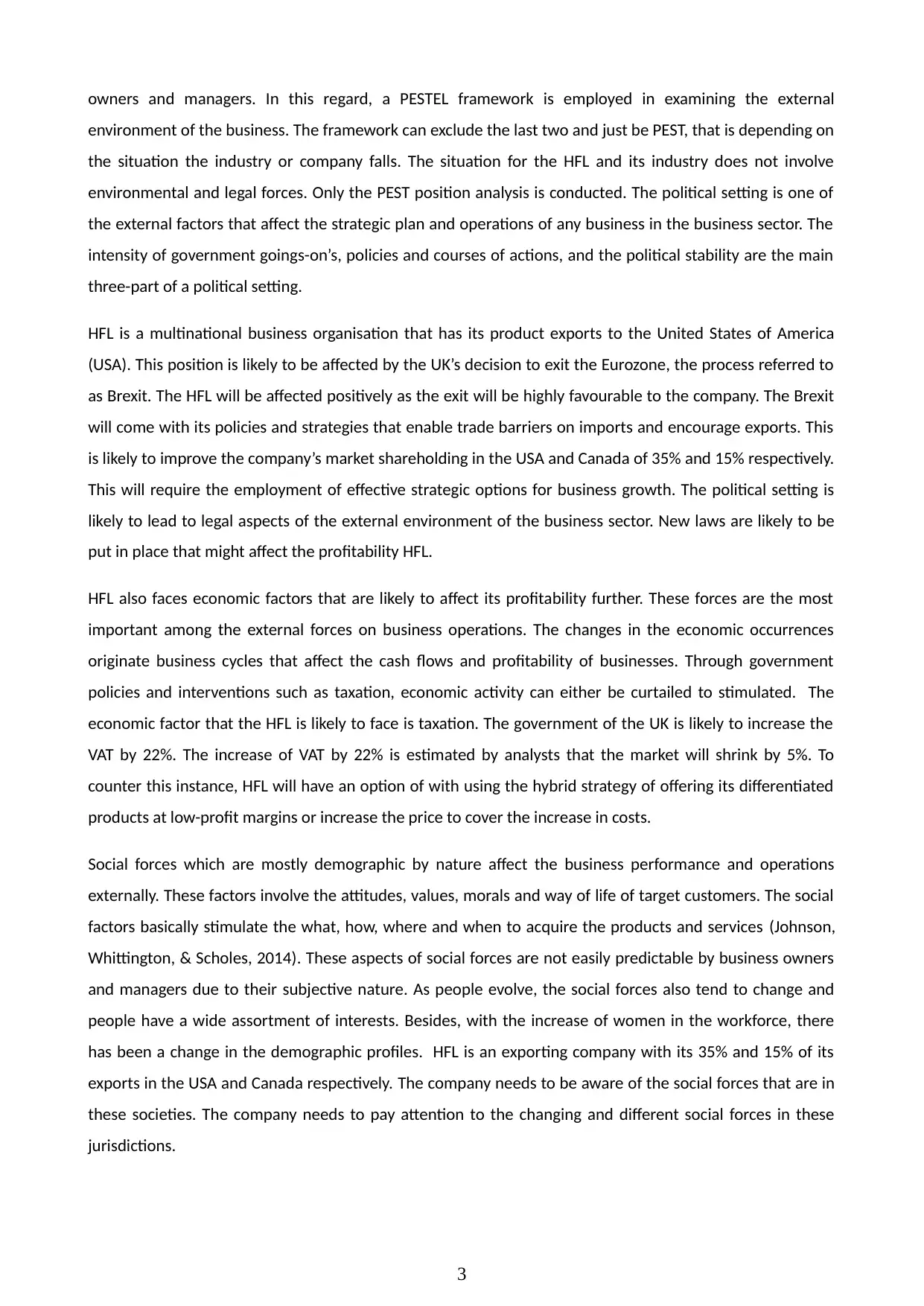
owners and managers. In this regard, a PESTEL framework is employed in examining the external
environment of the business. The framework can exclude the last two and just be PEST, that is depending on
the situation the industry or company falls. The situation for the HFL and its industry does not involve
environmental and legal forces. Only the PEST position analysis is conducted. The political setting is one of
the external factors that affect the strategic plan and operations of any business in the business sector. The
intensity of government goings-on’s, policies and courses of actions, and the political stability are the main
three-part of a political setting.
HFL is a multinational business organisation that has its product exports to the United States of America
(USA). This position is likely to be affected by the UK’s decision to exit the Eurozone, the process referred to
as Brexit. The HFL will be affected positively as the exit will be highly favourable to the company. The Brexit
will come with its policies and strategies that enable trade barriers on imports and encourage exports. This
is likely to improve the company’s market shareholding in the USA and Canada of 35% and 15% respectively.
This will require the employment of effective strategic options for business growth. The political setting is
likely to lead to legal aspects of the external environment of the business sector. New laws are likely to be
put in place that might affect the profitability HFL.
HFL also faces economic factors that are likely to affect its profitability further. These forces are the most
important among the external forces on business operations. The changes in the economic occurrences
originate business cycles that affect the cash flows and profitability of businesses. Through government
policies and interventions such as taxation, economic activity can either be curtailed to stimulated. The
economic factor that the HFL is likely to face is taxation. The government of the UK is likely to increase the
VAT by 22%. The increase of VAT by 22% is estimated by analysts that the market will shrink by 5%. To
counter this instance, HFL will have an option of with using the hybrid strategy of offering its differentiated
products at low-profit margins or increase the price to cover the increase in costs.
Social forces which are mostly demographic by nature affect the business performance and operations
externally. These factors involve the attitudes, values, morals and way of life of target customers. The social
factors basically stimulate the what, how, where and when to acquire the products and services (Johnson,
Whittington, & Scholes, 2014). These aspects of social forces are not easily predictable by business owners
and managers due to their subjective nature. As people evolve, the social forces also tend to change and
people have a wide assortment of interests. Besides, with the increase of women in the workforce, there
has been a change in the demographic profiles. HFL is an exporting company with its 35% and 15% of its
exports in the USA and Canada respectively. The company needs to be aware of the social forces that are in
these societies. The company needs to pay attention to the changing and different social forces in these
jurisdictions.
3
environment of the business. The framework can exclude the last two and just be PEST, that is depending on
the situation the industry or company falls. The situation for the HFL and its industry does not involve
environmental and legal forces. Only the PEST position analysis is conducted. The political setting is one of
the external factors that affect the strategic plan and operations of any business in the business sector. The
intensity of government goings-on’s, policies and courses of actions, and the political stability are the main
three-part of a political setting.
HFL is a multinational business organisation that has its product exports to the United States of America
(USA). This position is likely to be affected by the UK’s decision to exit the Eurozone, the process referred to
as Brexit. The HFL will be affected positively as the exit will be highly favourable to the company. The Brexit
will come with its policies and strategies that enable trade barriers on imports and encourage exports. This
is likely to improve the company’s market shareholding in the USA and Canada of 35% and 15% respectively.
This will require the employment of effective strategic options for business growth. The political setting is
likely to lead to legal aspects of the external environment of the business sector. New laws are likely to be
put in place that might affect the profitability HFL.
HFL also faces economic factors that are likely to affect its profitability further. These forces are the most
important among the external forces on business operations. The changes in the economic occurrences
originate business cycles that affect the cash flows and profitability of businesses. Through government
policies and interventions such as taxation, economic activity can either be curtailed to stimulated. The
economic factor that the HFL is likely to face is taxation. The government of the UK is likely to increase the
VAT by 22%. The increase of VAT by 22% is estimated by analysts that the market will shrink by 5%. To
counter this instance, HFL will have an option of with using the hybrid strategy of offering its differentiated
products at low-profit margins or increase the price to cover the increase in costs.
Social forces which are mostly demographic by nature affect the business performance and operations
externally. These factors involve the attitudes, values, morals and way of life of target customers. The social
factors basically stimulate the what, how, where and when to acquire the products and services (Johnson,
Whittington, & Scholes, 2014). These aspects of social forces are not easily predictable by business owners
and managers due to their subjective nature. As people evolve, the social forces also tend to change and
people have a wide assortment of interests. Besides, with the increase of women in the workforce, there
has been a change in the demographic profiles. HFL is an exporting company with its 35% and 15% of its
exports in the USA and Canada respectively. The company needs to be aware of the social forces that are in
these societies. The company needs to pay attention to the changing and different social forces in these
jurisdictions.
3
Paraphrase This Document
Need a fresh take? Get an instant paraphrase of this document with our AI Paraphraser
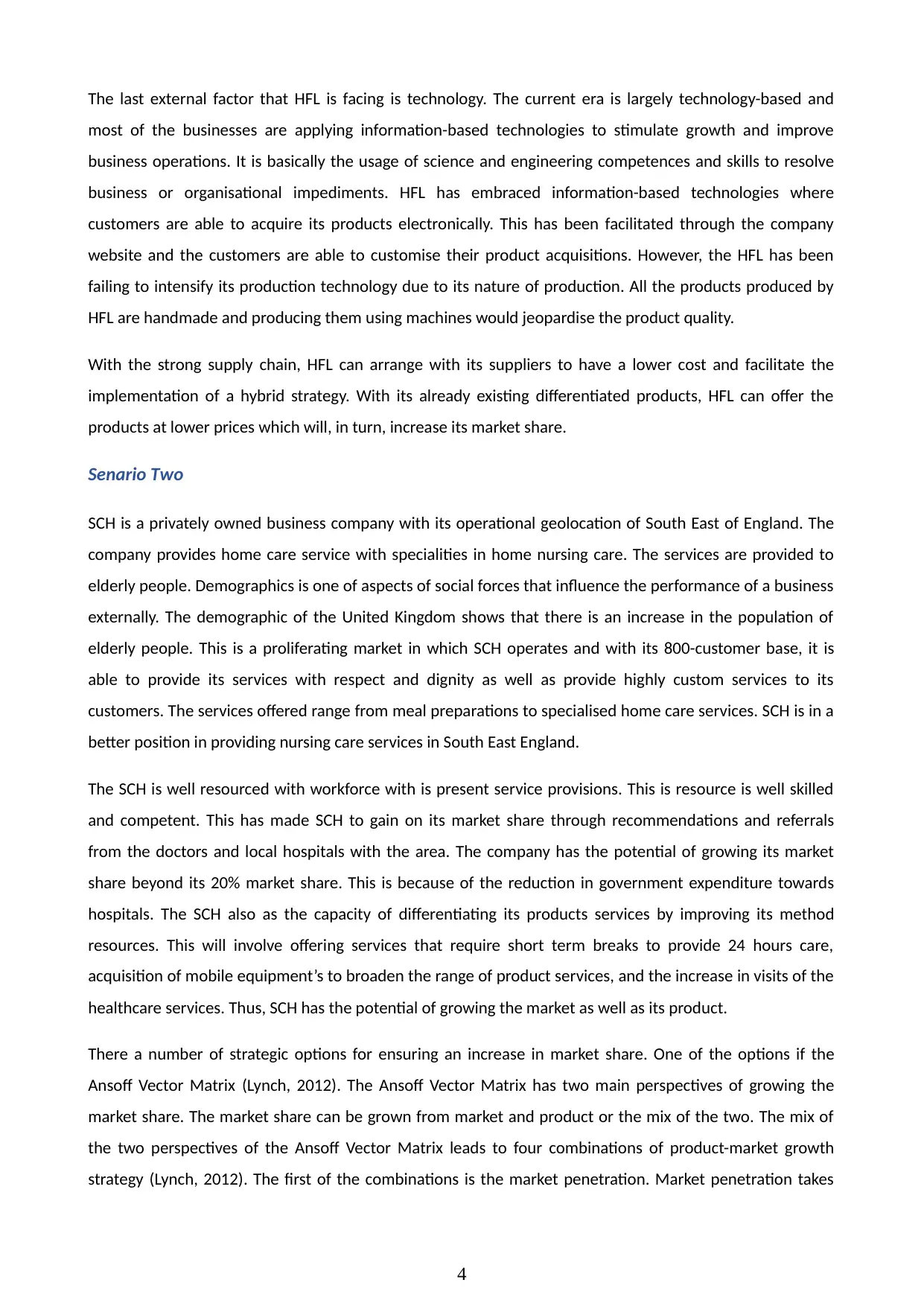
The last external factor that HFL is facing is technology. The current era is largely technology-based and
most of the businesses are applying information-based technologies to stimulate growth and improve
business operations. It is basically the usage of science and engineering competences and skills to resolve
business or organisational impediments. HFL has embraced information-based technologies where
customers are able to acquire its products electronically. This has been facilitated through the company
website and the customers are able to customise their product acquisitions. However, the HFL has been
failing to intensify its production technology due to its nature of production. All the products produced by
HFL are handmade and producing them using machines would jeopardise the product quality.
With the strong supply chain, HFL can arrange with its suppliers to have a lower cost and facilitate the
implementation of a hybrid strategy. With its already existing differentiated products, HFL can offer the
products at lower prices which will, in turn, increase its market share.
Senario Two
SCH is a privately owned business company with its operational geolocation of South East of England. The
company provides home care service with specialities in home nursing care. The services are provided to
elderly people. Demographics is one of aspects of social forces that influence the performance of a business
externally. The demographic of the United Kingdom shows that there is an increase in the population of
elderly people. This is a proliferating market in which SCH operates and with its 800-customer base, it is
able to provide its services with respect and dignity as well as provide highly custom services to its
customers. The services offered range from meal preparations to specialised home care services. SCH is in a
better position in providing nursing care services in South East England.
The SCH is well resourced with workforce with is present service provisions. This is resource is well skilled
and competent. This has made SCH to gain on its market share through recommendations and referrals
from the doctors and local hospitals with the area. The company has the potential of growing its market
share beyond its 20% market share. This is because of the reduction in government expenditure towards
hospitals. The SCH also as the capacity of differentiating its products services by improving its method
resources. This will involve offering services that require short term breaks to provide 24 hours care,
acquisition of mobile equipment’s to broaden the range of product services, and the increase in visits of the
healthcare services. Thus, SCH has the potential of growing the market as well as its product.
There a number of strategic options for ensuring an increase in market share. One of the options if the
Ansoff Vector Matrix (Lynch, 2012). The Ansoff Vector Matrix has two main perspectives of growing the
market share. The market share can be grown from market and product or the mix of the two. The mix of
the two perspectives of the Ansoff Vector Matrix leads to four combinations of product-market growth
strategy (Lynch, 2012). The first of the combinations is the market penetration. Market penetration takes
4
most of the businesses are applying information-based technologies to stimulate growth and improve
business operations. It is basically the usage of science and engineering competences and skills to resolve
business or organisational impediments. HFL has embraced information-based technologies where
customers are able to acquire its products electronically. This has been facilitated through the company
website and the customers are able to customise their product acquisitions. However, the HFL has been
failing to intensify its production technology due to its nature of production. All the products produced by
HFL are handmade and producing them using machines would jeopardise the product quality.
With the strong supply chain, HFL can arrange with its suppliers to have a lower cost and facilitate the
implementation of a hybrid strategy. With its already existing differentiated products, HFL can offer the
products at lower prices which will, in turn, increase its market share.
Senario Two
SCH is a privately owned business company with its operational geolocation of South East of England. The
company provides home care service with specialities in home nursing care. The services are provided to
elderly people. Demographics is one of aspects of social forces that influence the performance of a business
externally. The demographic of the United Kingdom shows that there is an increase in the population of
elderly people. This is a proliferating market in which SCH operates and with its 800-customer base, it is
able to provide its services with respect and dignity as well as provide highly custom services to its
customers. The services offered range from meal preparations to specialised home care services. SCH is in a
better position in providing nursing care services in South East England.
The SCH is well resourced with workforce with is present service provisions. This is resource is well skilled
and competent. This has made SCH to gain on its market share through recommendations and referrals
from the doctors and local hospitals with the area. The company has the potential of growing its market
share beyond its 20% market share. This is because of the reduction in government expenditure towards
hospitals. The SCH also as the capacity of differentiating its products services by improving its method
resources. This will involve offering services that require short term breaks to provide 24 hours care,
acquisition of mobile equipment’s to broaden the range of product services, and the increase in visits of the
healthcare services. Thus, SCH has the potential of growing the market as well as its product.
There a number of strategic options for ensuring an increase in market share. One of the options if the
Ansoff Vector Matrix (Lynch, 2012). The Ansoff Vector Matrix has two main perspectives of growing the
market share. The market share can be grown from market and product or the mix of the two. The mix of
the two perspectives of the Ansoff Vector Matrix leads to four combinations of product-market growth
strategy (Lynch, 2012). The first of the combinations is the market penetration. Market penetration takes
4
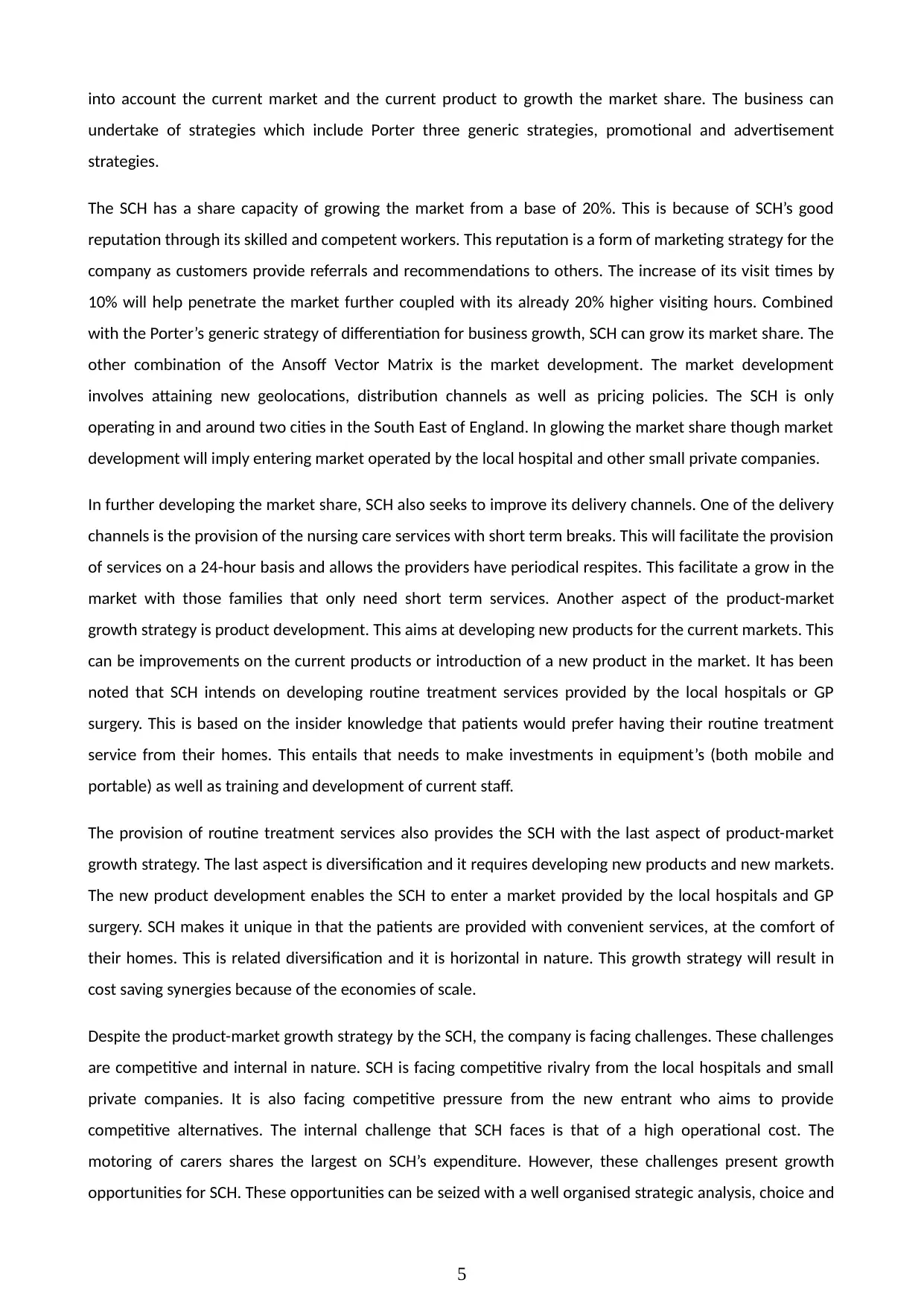
into account the current market and the current product to growth the market share. The business can
undertake of strategies which include Porter three generic strategies, promotional and advertisement
strategies.
The SCH has a share capacity of growing the market from a base of 20%. This is because of SCH’s good
reputation through its skilled and competent workers. This reputation is a form of marketing strategy for the
company as customers provide referrals and recommendations to others. The increase of its visit times by
10% will help penetrate the market further coupled with its already 20% higher visiting hours. Combined
with the Porter’s generic strategy of differentiation for business growth, SCH can grow its market share. The
other combination of the Ansoff Vector Matrix is the market development. The market development
involves attaining new geolocations, distribution channels as well as pricing policies. The SCH is only
operating in and around two cities in the South East of England. In glowing the market share though market
development will imply entering market operated by the local hospital and other small private companies.
In further developing the market share, SCH also seeks to improve its delivery channels. One of the delivery
channels is the provision of the nursing care services with short term breaks. This will facilitate the provision
of services on a 24-hour basis and allows the providers have periodical respites. This facilitate a grow in the
market with those families that only need short term services. Another aspect of the product-market
growth strategy is product development. This aims at developing new products for the current markets. This
can be improvements on the current products or introduction of a new product in the market. It has been
noted that SCH intends on developing routine treatment services provided by the local hospitals or GP
surgery. This is based on the insider knowledge that patients would prefer having their routine treatment
service from their homes. This entails that needs to make investments in equipment’s (both mobile and
portable) as well as training and development of current staff.
The provision of routine treatment services also provides the SCH with the last aspect of product-market
growth strategy. The last aspect is diversification and it requires developing new products and new markets.
The new product development enables the SCH to enter a market provided by the local hospitals and GP
surgery. SCH makes it unique in that the patients are provided with convenient services, at the comfort of
their homes. This is related diversification and it is horizontal in nature. This growth strategy will result in
cost saving synergies because of the economies of scale.
Despite the product-market growth strategy by the SCH, the company is facing challenges. These challenges
are competitive and internal in nature. SCH is facing competitive rivalry from the local hospitals and small
private companies. It is also facing competitive pressure from the new entrant who aims to provide
competitive alternatives. The internal challenge that SCH faces is that of a high operational cost. The
motoring of carers shares the largest on SCH’s expenditure. However, these challenges present growth
opportunities for SCH. These opportunities can be seized with a well organised strategic analysis, choice and
5
undertake of strategies which include Porter three generic strategies, promotional and advertisement
strategies.
The SCH has a share capacity of growing the market from a base of 20%. This is because of SCH’s good
reputation through its skilled and competent workers. This reputation is a form of marketing strategy for the
company as customers provide referrals and recommendations to others. The increase of its visit times by
10% will help penetrate the market further coupled with its already 20% higher visiting hours. Combined
with the Porter’s generic strategy of differentiation for business growth, SCH can grow its market share. The
other combination of the Ansoff Vector Matrix is the market development. The market development
involves attaining new geolocations, distribution channels as well as pricing policies. The SCH is only
operating in and around two cities in the South East of England. In glowing the market share though market
development will imply entering market operated by the local hospital and other small private companies.
In further developing the market share, SCH also seeks to improve its delivery channels. One of the delivery
channels is the provision of the nursing care services with short term breaks. This will facilitate the provision
of services on a 24-hour basis and allows the providers have periodical respites. This facilitate a grow in the
market with those families that only need short term services. Another aspect of the product-market
growth strategy is product development. This aims at developing new products for the current markets. This
can be improvements on the current products or introduction of a new product in the market. It has been
noted that SCH intends on developing routine treatment services provided by the local hospitals or GP
surgery. This is based on the insider knowledge that patients would prefer having their routine treatment
service from their homes. This entails that needs to make investments in equipment’s (both mobile and
portable) as well as training and development of current staff.
The provision of routine treatment services also provides the SCH with the last aspect of product-market
growth strategy. The last aspect is diversification and it requires developing new products and new markets.
The new product development enables the SCH to enter a market provided by the local hospitals and GP
surgery. SCH makes it unique in that the patients are provided with convenient services, at the comfort of
their homes. This is related diversification and it is horizontal in nature. This growth strategy will result in
cost saving synergies because of the economies of scale.
Despite the product-market growth strategy by the SCH, the company is facing challenges. These challenges
are competitive and internal in nature. SCH is facing competitive rivalry from the local hospitals and small
private companies. It is also facing competitive pressure from the new entrant who aims to provide
competitive alternatives. The internal challenge that SCH faces is that of a high operational cost. The
motoring of carers shares the largest on SCH’s expenditure. However, these challenges present growth
opportunities for SCH. These opportunities can be seized with a well organised strategic analysis, choice and
5
You're viewing a preview
Unlock full access by subscribing today!
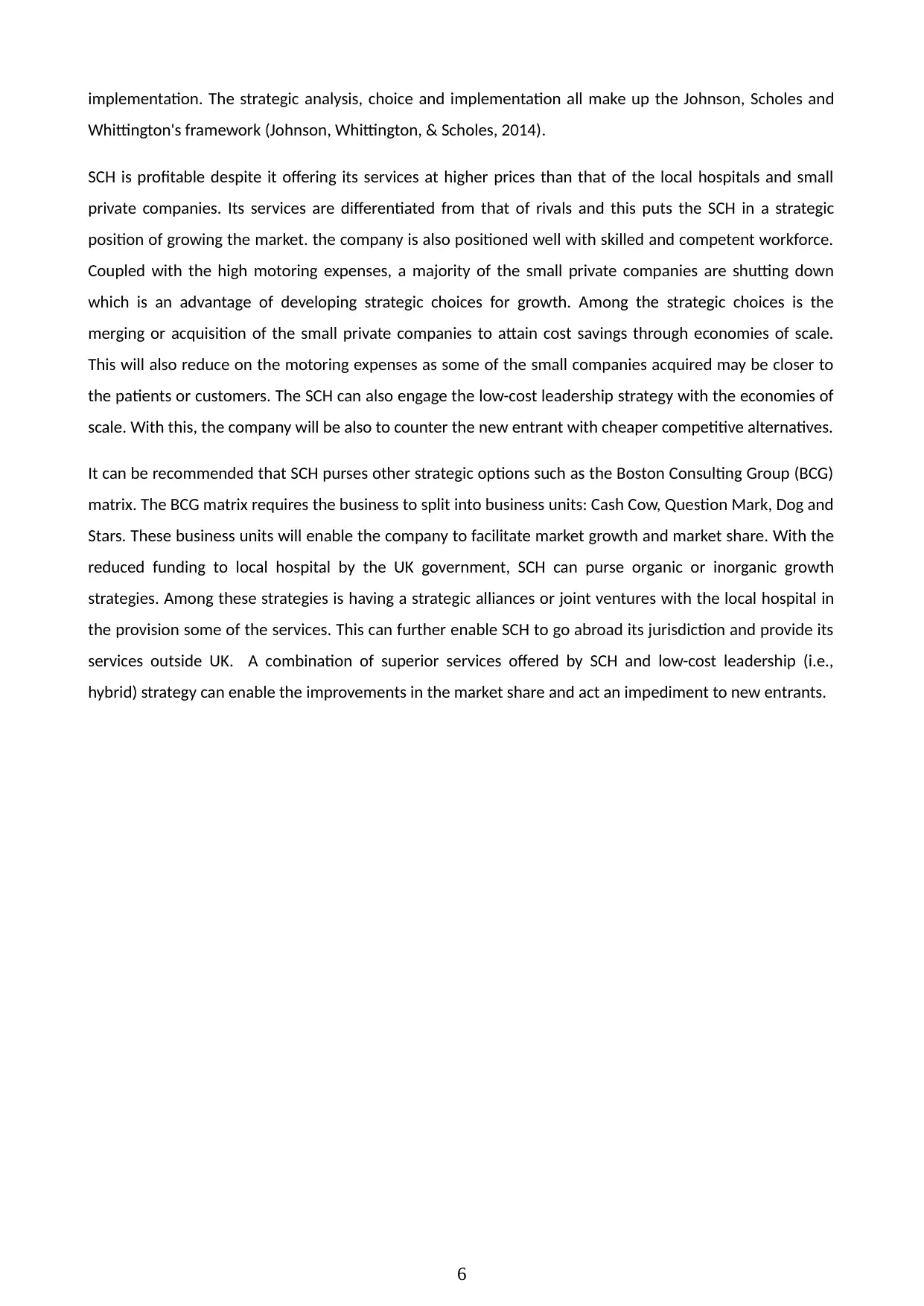
implementation. The strategic analysis, choice and implementation all make up the Johnson, Scholes and
Whittington's framework (Johnson, Whittington, & Scholes, 2014).
SCH is profitable despite it offering its services at higher prices than that of the local hospitals and small
private companies. Its services are differentiated from that of rivals and this puts the SCH in a strategic
position of growing the market. the company is also positioned well with skilled and competent workforce.
Coupled with the high motoring expenses, a majority of the small private companies are shutting down
which is an advantage of developing strategic choices for growth. Among the strategic choices is the
merging or acquisition of the small private companies to attain cost savings through economies of scale.
This will also reduce on the motoring expenses as some of the small companies acquired may be closer to
the patients or customers. The SCH can also engage the low-cost leadership strategy with the economies of
scale. With this, the company will be also to counter the new entrant with cheaper competitive alternatives.
It can be recommended that SCH purses other strategic options such as the Boston Consulting Group (BCG)
matrix. The BCG matrix requires the business to split into business units: Cash Cow, Question Mark, Dog and
Stars. These business units will enable the company to facilitate market growth and market share. With the
reduced funding to local hospital by the UK government, SCH can purse organic or inorganic growth
strategies. Among these strategies is having a strategic alliances or joint ventures with the local hospital in
the provision some of the services. This can further enable SCH to go abroad its jurisdiction and provide its
services outside UK. A combination of superior services offered by SCH and low-cost leadership (i.e.,
hybrid) strategy can enable the improvements in the market share and act an impediment to new entrants.
6
Whittington's framework (Johnson, Whittington, & Scholes, 2014).
SCH is profitable despite it offering its services at higher prices than that of the local hospitals and small
private companies. Its services are differentiated from that of rivals and this puts the SCH in a strategic
position of growing the market. the company is also positioned well with skilled and competent workforce.
Coupled with the high motoring expenses, a majority of the small private companies are shutting down
which is an advantage of developing strategic choices for growth. Among the strategic choices is the
merging or acquisition of the small private companies to attain cost savings through economies of scale.
This will also reduce on the motoring expenses as some of the small companies acquired may be closer to
the patients or customers. The SCH can also engage the low-cost leadership strategy with the economies of
scale. With this, the company will be also to counter the new entrant with cheaper competitive alternatives.
It can be recommended that SCH purses other strategic options such as the Boston Consulting Group (BCG)
matrix. The BCG matrix requires the business to split into business units: Cash Cow, Question Mark, Dog and
Stars. These business units will enable the company to facilitate market growth and market share. With the
reduced funding to local hospital by the UK government, SCH can purse organic or inorganic growth
strategies. Among these strategies is having a strategic alliances or joint ventures with the local hospital in
the provision some of the services. This can further enable SCH to go abroad its jurisdiction and provide its
services outside UK. A combination of superior services offered by SCH and low-cost leadership (i.e.,
hybrid) strategy can enable the improvements in the market share and act an impediment to new entrants.
6
Paraphrase This Document
Need a fresh take? Get an instant paraphrase of this document with our AI Paraphraser
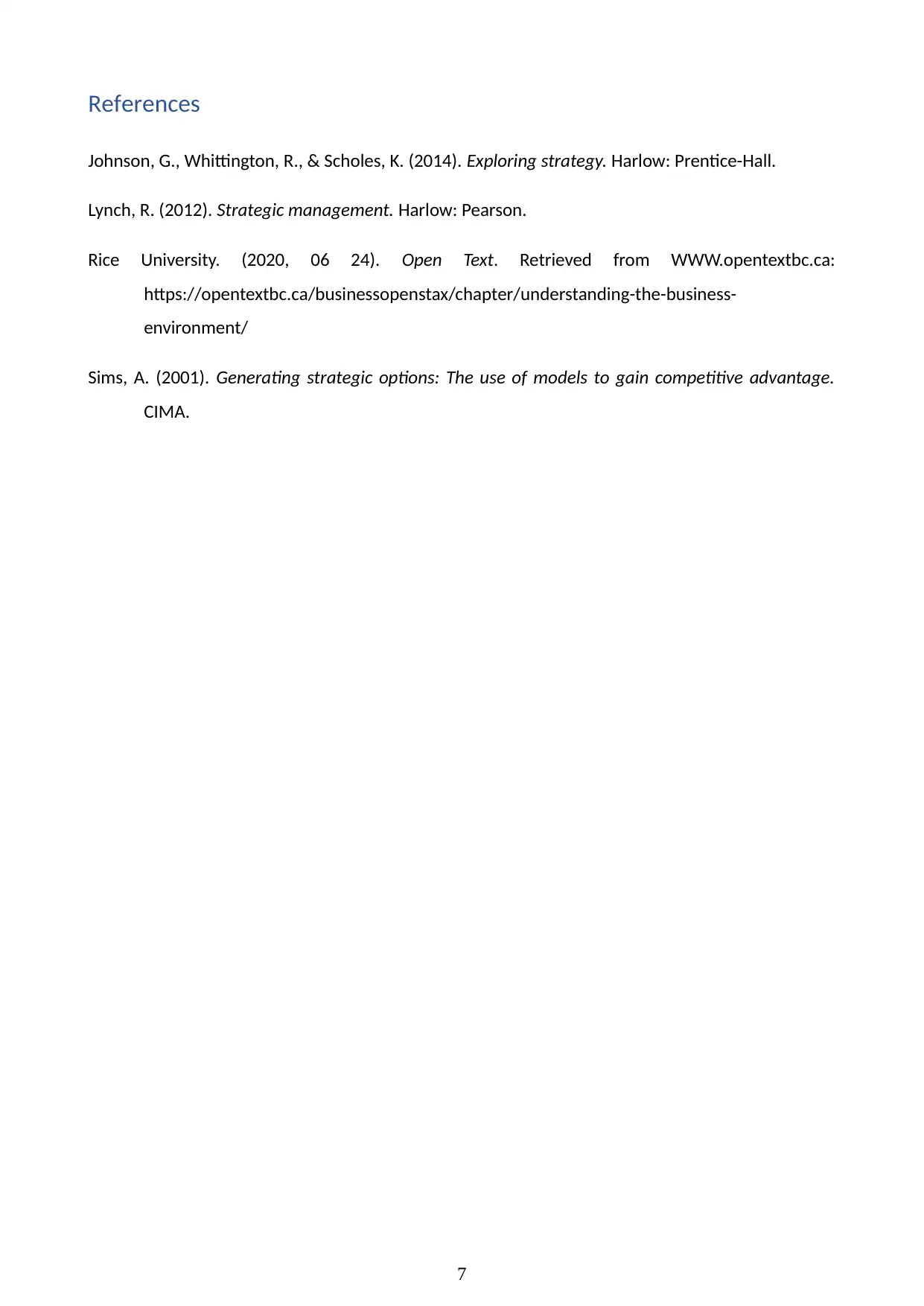
References
Johnson, G., Whittington, R., & Scholes, K. (2014). Exploring strategy. Harlow: Prentice-Hall.
Lynch, R. (2012). Strategic management. Harlow: Pearson.
Rice University. (2020, 06 24). Open Text. Retrieved from WWW.opentextbc.ca:
https://opentextbc.ca/businessopenstax/chapter/understanding-the-business-
environment/
Sims, A. (2001). Generating strategic options: The use of models to gain competitive advantage.
CIMA.
7
Johnson, G., Whittington, R., & Scholes, K. (2014). Exploring strategy. Harlow: Prentice-Hall.
Lynch, R. (2012). Strategic management. Harlow: Pearson.
Rice University. (2020, 06 24). Open Text. Retrieved from WWW.opentextbc.ca:
https://opentextbc.ca/businessopenstax/chapter/understanding-the-business-
environment/
Sims, A. (2001). Generating strategic options: The use of models to gain competitive advantage.
CIMA.
7
1 out of 8
Related Documents
Your All-in-One AI-Powered Toolkit for Academic Success.
+13062052269
info@desklib.com
Available 24*7 on WhatsApp / Email
![[object Object]](/_next/static/media/star-bottom.7253800d.svg)
Unlock your academic potential
© 2024 | Zucol Services PVT LTD | All rights reserved.





